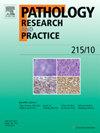Gaucher-like crystal-storing histiocytosis associated with kappa chain myeloma: A case report with next generation sequencing study
IF 2.9
4区 医学
Q2 PATHOLOGY
引用次数: 0
Abstract
Crystal-storing histiocytosis is a rare entity due to tumorous deposits of histiocytes containing crystalline inclusions, which in a majority of cases are made of immunoglobulins associated with lymphoproliferative disorders, although association with non-neoplastic disorders has also been reported. The histiocytes may be so abundant to obscure the underlying lymphoplasmacytic neoplasm. On the other hand, the Gaucher-like histiocytes might lead to a misinterpretation of granulomatous inflammation or storage disease. Herein, this case study reported clinical, pathological and next generation sequencing (NGS) features of a case of kappa chain myeloma with Gaucher-like crystal-storing histiocytosis in the bone marrow (BM). The methodology included BM aspiration and biopsy, immunohistochemistry, electron microscopy and NGS study by TruSight Oncology 500. Morphologically, the BM smear showed dense infiltration of sea blue histiocytes and atypical plasma cells with rhomboid crystals in cytoplasm. The BM biopsy showed excessive plasmacytic aggregates and dense histiocytic infiltrates with wrinkled paper-like or needle shaped cytoplasm. These plasma cells were positive for CD138 and showed lambda chain restriction. Electron microscopy highlighted the long rhomboid crystals with distinct periodicity consistent with crystalline immunoglobulins in the histiocytes. In addition, the NGS study from the BM aspiration specimen revealed PARP1, MSH6, KDR, CCND3 and STK11 mutations, which might be associated with inferior survival of myeloma patients. Accordingly, this case died of pneumonia with septic shock during treatment. Our findings suggest that the presence of rhomboid crystals in bone marrow smears may alert pathologists to look for the possibility of crystal-storing histiocytosis and the prognosis of patients with multiple myeloma may depend on the genetic features of tumor cells rather than the association with crystal-storing histiocytosis.
伴有卡帕链骨髓瘤的高雪氏样晶体贮积组织细胞增多症:病例报告与新一代测序研究。
晶体贮积组织细胞增生症是一种罕见的组织细胞肿瘤性沉积,内含晶体包涵体,大多数病例由与淋巴细胞增生性疾病有关的免疫球蛋白组成,但也有与非肿瘤性疾病有关的报道。组织细胞可能非常丰富,以至于掩盖了潜在的淋巴浆细胞性肿瘤。另一方面,戈谢样组织细胞可能会导致误诊为肉芽肿性炎症或储积性疾病。在此,本病例研究报告了一例kappa链骨髓瘤伴骨髓(BM)戈谢样晶体贮积组织细胞病的临床、病理和新一代测序(NGS)特征。研究方法包括骨髓抽吸和活检、免疫组化、电子显微镜和 TruSight Oncology 500 的 NGS 研究。从形态上看,BM 涂片显示海蓝色组织细胞和非典型浆细胞密集浸润,胞浆中有斜方形晶体。生化组织活检显示,浆细胞聚集过多,组织细胞密集浸润,胞浆呈皱纹纸状或针状。这些浆细胞的CD138呈阳性,并显示出λ链限制。电子显微镜突出显示了长斜方形晶体,其明显的周期性与组织细胞中的结晶免疫球蛋白一致。此外,对骨髓穿刺标本进行的 NGS 研究发现了 PARP1、MSH6、KDR、CCND3 和 STK11 基因突变,这些突变可能与骨髓瘤患者的低生存率有关。因此,该病例在治疗过程中死于肺炎和脓毒性休克。我们的研究结果表明,骨髓涂片中出现斜方形结晶可提醒病理学家注意晶体贮积组织细胞病的可能性,多发性骨髓瘤患者的预后可能取决于肿瘤细胞的遗传特征,而不是与晶体贮积组织细胞病的关联。
本文章由计算机程序翻译,如有差异,请以英文原文为准。
求助全文
约1分钟内获得全文
求助全文
来源期刊
CiteScore
5.00
自引率
3.60%
发文量
405
审稿时长
24 days
期刊介绍:
Pathology, Research and Practice provides accessible coverage of the most recent developments across the entire field of pathology: Reviews focus on recent progress in pathology, while Comments look at interesting current problems and at hypotheses for future developments in pathology. Original Papers present novel findings on all aspects of general, anatomic and molecular pathology. Rapid Communications inform readers on preliminary findings that may be relevant for further studies and need to be communicated quickly. Teaching Cases look at new aspects or special diagnostic problems of diseases and at case reports relevant for the pathologist''s practice.

 求助内容:
求助内容: 应助结果提醒方式:
应助结果提醒方式:


